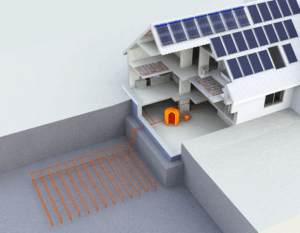Introduction
Discover how Canadian farms are revolutionizing agriculture with geothermal energy. This article explores real-world applications of geothermal technology in greenhouses, dairy farms, and grain drying operations across Canada. Learn about the economic and environmental benefits of geothermal energy in farming, including year-round crop production and significant CO2 emission reductions. Understand the challenges, government initiatives, and future prospects of geothermal energy in Canadian agriculture. Perfect for farmers, environmentalists, and anyone interested in sustainable farming practices and renewable energy applications in cold climates.
Lacombe, Alberta
On a frigid January morning in Lacombe, Alberta, while most fields lie dormant under a blanket of snow, Eric Doef’s greenhouse buzzes with activity. Tomato vines stretch towards the ceiling, heavy with ripening fruit. This scene, seemingly at odds with the harsh Canadian winter outside, is made possible by an invisible force humming beneath the soil: geothermal energy.
“It’s revolutionary,” Doef explains, gesturing to the thriving plants around him. “We’re growing fresh, local produce year-round in Alberta, and our energy bills have dropped by 50% since we installed the geothermal system.”
Doef’s greenhouse is just one example of how geothermal energy is quietly transforming Canadian agriculture. But what exactly is this technology, and how is it helping farmers across the country?
The Basics: What is Geothermal Energy?
At its core, geothermal energy is heat from the Earth. Just a few meters below the surface, the ground maintains a nearly constant temperature, ranging from 10°C to 16°C depending on latitude. Geothermal systems tap into this steady heat source, using it to warm buildings in winter and cool them in summer.
According to Natural Resources Canada, the country’s theoretical geothermal energy potential exceeds 5 million megawatts. That’s enough to power millions of homes and farms. But how are farmers putting this potential to use?
Greenhouse Revolution: Growing Through the Winter
Back in Lacombe, Eric Doef’s operation, Doef’s Greenhouses, has been using a ground-source heat pump system since 2009. By circulating fluid through underground pipes, the system extracts heat from the earth in winter and dumps excess heat back into the ground in summer.
The results speak for themselves. “We’ve cut our heating costs by half,” Doef reports. “And we’re producing local vegetables year-round, even when it’s -30°C outside.”
This isn’t just good for Doef’s bottom line; it’s also a win for the environment. The Pembina Institute estimates that if geothermal heating were widely adopted in Canadian greenhouses, it could reduce annual CO2 emissions by up to 600,000 tonnes. That’s equivalent to taking about 130,000 cars off the road for a year.
Beyond Greenhouses: Diverse Applications on Canadian Farms
While greenhouse heating is perhaps the most visible application of geothermal energy in Canadian agriculture, it’s far from the only one.
In the dairy industry, farms like Groenewegen Farms in Chilliwack, B.C., are using geothermal energy to heat water for cleaning equipment and facilities. “It’s cut our water heating costs by 75%,” says dairy farmer Dick Groenewegen. “Plus, it’s reduced our carbon footprint significantly.”
Meanwhile, in the grain belt, some farmers are exploring geothermal energy for crop drying. Traditional grain dryers are energy-intensive, often relying on propane or natural gas. Geothermal systems offer a more sustainable alternative.
“We’re still in the early stages,” admits Sarah Johnson, a grain farmer in Saskatchewan who’s piloting a geothermal grain drying system. “But initial results are promising. We’re seeing energy savings of about 40% compared to our old propane system.”
Challenges and Considerations
Despite its potential, geothermal energy isn’t without challenges. The upfront costs can be significant. According to the Canadian Geoexchange Coalition, installation costs for farm-scale systems can range from $20,000 to several million dollars, depending on the size and complexity of the operation.
There’s also the matter of geological suitability. Not all locations are ideal for geothermal energy extraction. “Before installing any system, you need a thorough site assessment,” cautions Dr. Stephen Grasby, a geologist with Natural Resources Canada. “The potential varies greatly depending on local geology.”
Government Support and Future Outlook
Recognizing the potential of geothermal energy in agriculture, various government initiatives are helping to offset costs and drive adoption. The federal government’s Clean Energy for Rural and Remote Communities Program, for instance, offers funding for clean energy projects, including geothermal, in rural areas.
Additionally, programs like the Scientific Research and Experimental Development (SR&ED) Tax Incentive are supporting ongoing research and development in the field.
Looking ahead, emerging technologies like Enhanced Geothermal Systems (EGS) could expand the viability of geothermal energy to more regions. “EGS could potentially make geothermal energy accessible almost anywhere,” explains Dr. Grasby. “But we’re still in the research phase for these advanced systems.”
Conclusion: A Warming Trend in Canadian Agriculture
As Eric Doef tends to his winter tomatoes in Alberta, Sarah Johnson monitors her grain dryer in Saskatchewan, and Dick Groenewegen manages his dairy operation in B.C., they’re all part of a growing trend in Canadian agriculture. They’re tapping into the earth’s heat to make their farms more sustainable, more productive, and more resilient in the face of rising energy costs and climate change.
While geothermal energy isn’t a one-size-fits-all solution, its potential to transform Canadian farming is clear. As technology advances and more farmers share their success stories, we may well see a future where Canada’s harsh winters are no match for the steady warmth beneath our feet.



